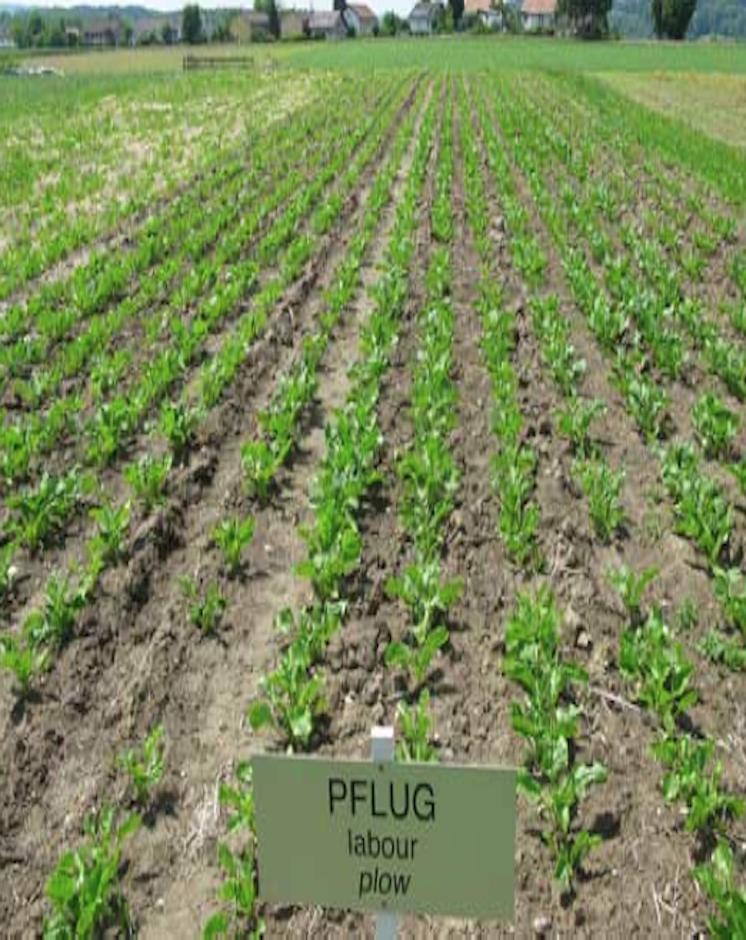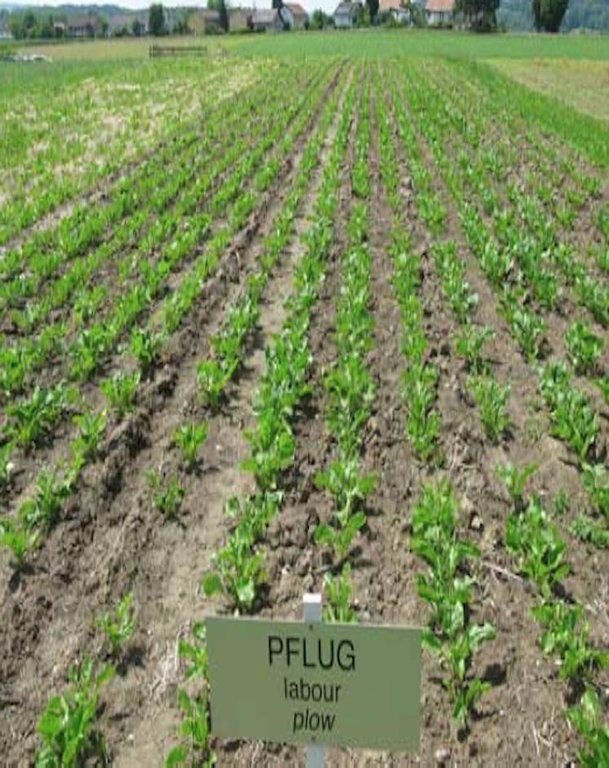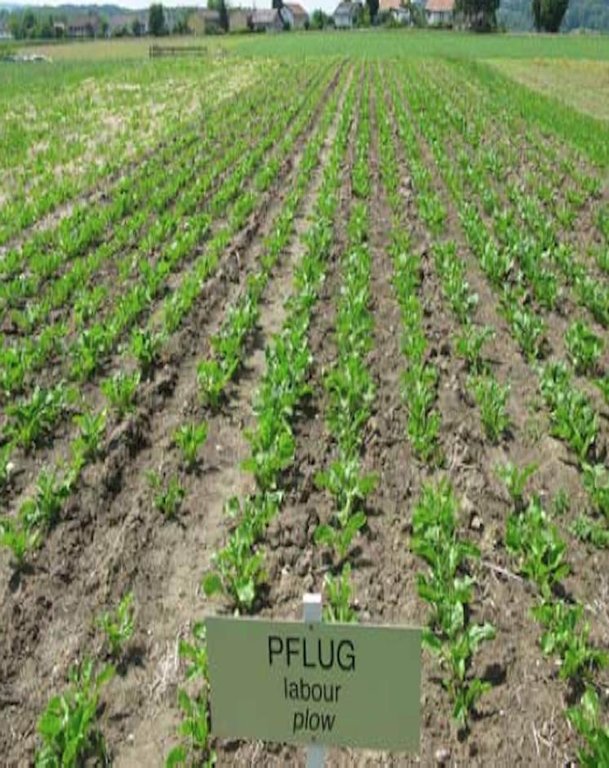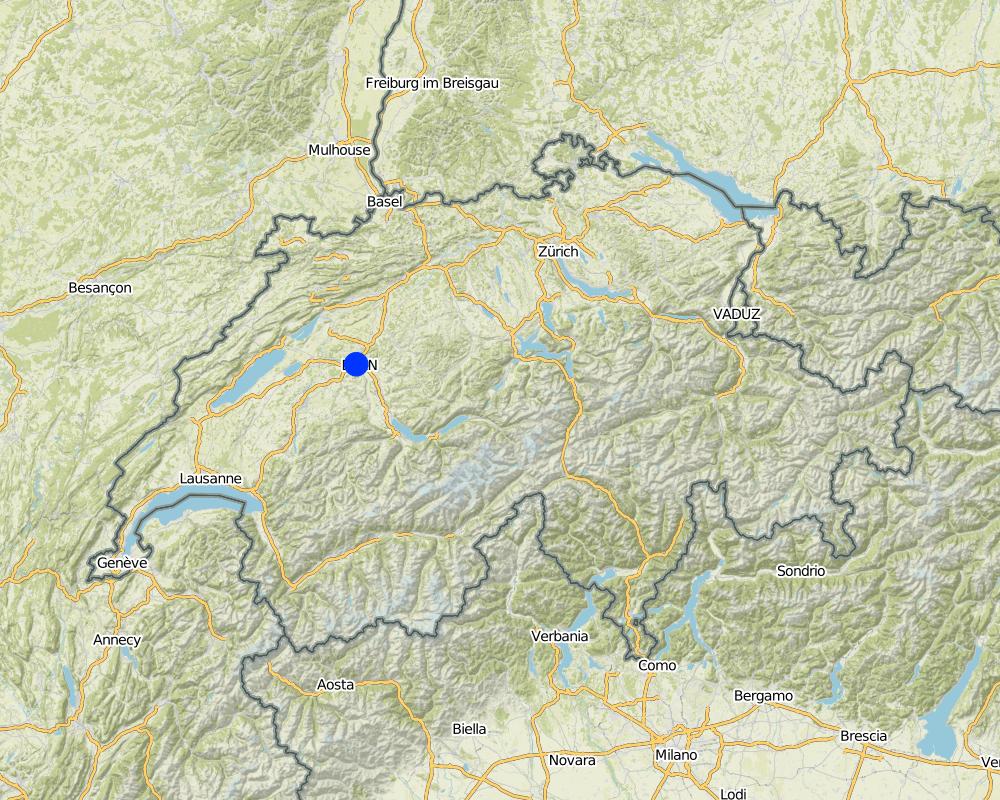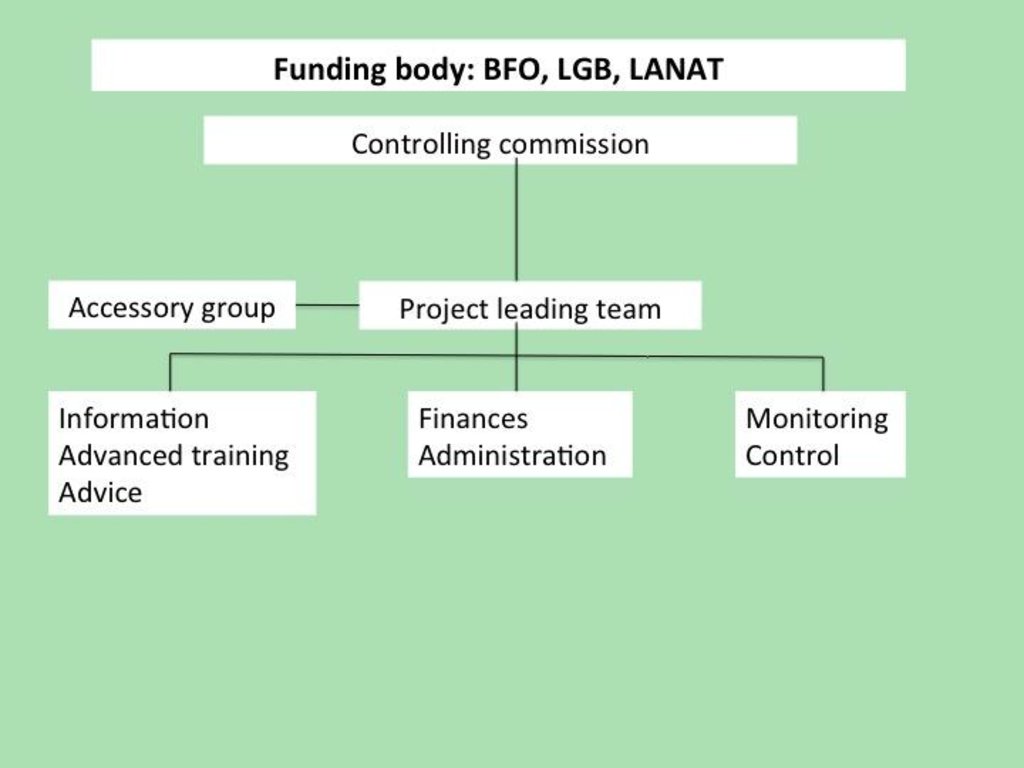Soil support program for conservation agriculture [Швейцария]
- Создание:
- Обновить:
- Составитель: Deborah Niggli
- Редактор: –
- Рецензент: David Streiff
Förderprogramm Boden des Kantons Bern
approaches_2525 - Швейцария
Просмотреть разделы
Развернуть все Свернуть все1. Общая информация
1.2 Контактные данные специалистов и организаций, участвующих в описании и оценке Подхода
Специалист по УЗП:
Sturny Wolfgang
wolfgang.sturny@vol.be.ch
Fachstelle Bodenschutz des Kantons Bern
Rütti, 3052 Zollikofen
Швейцария
Название проекта, содействовавшего документированию/оценке Подхода (если применимо)
Preventing and Remediating degradation of soils in Europe through Land Care (EU-RECARE )Название организации (-ий), содействовавших документированию/оценке Подхода (если применимо)
CDE Centre for Development and Environment (CDE Centre for Development and Environment) - Швейцария1.3 Условия, регламентирующие использование собранных ВОКАТ данных
Когда были собраны данные (на местах)?
06/05/2015
Составитель и ответственный/-ые специалист(-ы) согласны с условиями, регламентирующими использование собранных ВОКАТ данных:
Да
1.4 Ссылка (-и) на Анкету (-ы) по Технологиям УЗП

Maize strip tillage [Швейцария]
A cropping system for maize which reduces the reworking of the soil to the stripes, in which the seeds are planted.
- Составитель: Roman Wyler
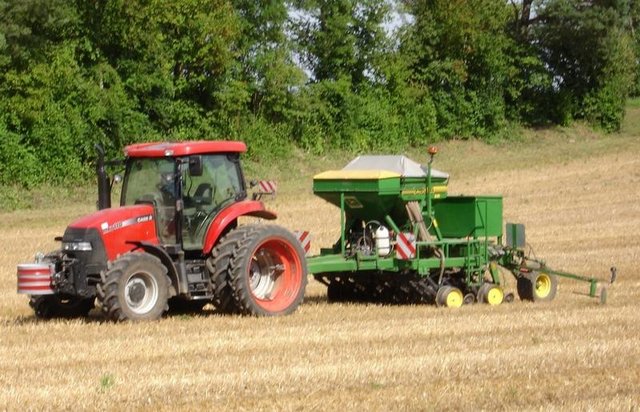
Direct seeding [Швейцария]
A cropping system which allows to plant the seeds directly into the soil without ploughing. The soil is covered with plant remainders.
- Составитель: Unknown User
2. Описание Подхода УЗП
2.1 Краткое описание Подхода
Through the soil support program land users get subsidies for applying conservation technologies on their fields during a period of 6 years.
2.2 Подробное описание Подхода
Подробное описание Подхода:
Aims / objectives: The aim of the office of soil protection is to enhance the implementation of conservation agriculture technologies by swiss land users. Therefore land users can test different technologies for 6 years within the soil support program. For each technology and method they apply they get paid by the government. Thus the functional character of soil and the soil biology are preserved, soil erosion and soil compaction are prevented and production of ammoniac is reduced.
Methods: The aims named above can be reached by implementing conservation agriculture technologies such as direct seeding or mulching. Therefore, land users get a financial incentive for using and implementing such technologies on their own fields. They apply for a period of 6 years to use conservation technologies. At the beginning, at least two different technologies must be chosen. There are different technologies in the field of soil protecting cropping systems, soil composition and ammoniac reducing spreading systems. Moreover, the office of soil protection has its own testing fields where land users get an overview over the different technologies and can then decide on which method they want to apply. After a land user gets a contract, planning and details about the technology and the process of implementation are discussed separately with an advisor of the program.
A database with all information necessary for land users and controlling institutions is also granted by the office. Controllers of the local government must check the field and the implementation of the technologies of a participant land user at least once a year.
Stages of implementation: The soil support program of the Canton Bern is an extension of a previous program. Results of this previous program showed that regarding soil pollution, soil erosion and loss of nitrogen agricultural production can even be improved when using conservation technologies. Through a new agricultural policy in 2007 government is able to provide financial support for projects enhancing protection of natural resources. The soil support program was then approved 2008 and started its 6-year program in 2009. To promote this project different descriptions were made in press and media, a homepage was launched and through soil days and public speeches information was spread under land users.
When implementing a conservation technology land users get advice and consultations directly through advisors in order to provide as much information and help as possible.
Role of stakeholders: Land users are the most important group of stakeholders. They need to apply to the program and change their cropping system and implement conservation technologies. At the beginning there are many critics among them who don't trust conservation technologies to be as effective and productive as their traditionalist ones. Land users open to a change and concerning the benefit for natural and biological environment apply to the program. It is very important to involve land users and their views and concerns into the process of planning after the contract but also even at the very beginning of the program. If technologies are not compatible with their views they are not going to fully implement a technology and keep it after the program.
Advisors are employed by the program administration. It is their job to provide help to the land users. They are most important in the beginning when a land user chooses his conservation technology. They are on field together with the land user and discuss the best possible technology for the land user. To find the appropriate technology is always a tricky task.
Government and local government play the crucial role of money lenders and supervisors. Representatives of the local government need to check a land user and the application of his conservation technology at least once a year. If it is approved government provides the payment in form of subsidies for the conservation technology applied by the land user. This amount differs from technology to technology.
2.3 Фотографии, иллюстрирующие Подход
2.5 Страна/ регион/ место, где применялся Подход
Страна:
Швейцария
Административная единица (Район/Область):
Canton Bern
Комментарии:
Canton of Bern
Map
×2.6 Даты начала и окончания реализации Подхода
Год начала реализации:
1993
Год окончания (Если Подход больше не применяется):
2015
2.7 Тип Подхода
- в рамках проекта/ программы
2.8 Каковы цели/ задачи Подхода
The Approach focused mainly on SLM with other activities (water and air pollution, biodiversity, rethinking agricultural practises)
The main aim of the program was to implement conservation technologies into the livelihood of swiss land users. Because of financial incentives land user even get subsidies for implementing a conservation technology on their fields. The other objective not only of the project was to get land users to overthink their traditional view of agriculture and to focus more on the conservation of natural environment and especially soil. Through the project land users shall be encouraged to carry on with the conservation technology they applied in the project. Thus, the main aims focus especially on the implementation and continuation of sustainable land use technologies in swiss agriculture.
The SLM Approach addressed the following problems: Das Hauptproblem zu Beginn des Projekts war die Unwissenheit der Bauern. So kam es teilweise zu Ernteverlusten durch falsche Anwendung einer Massnahme. Zudem ignorierten einige Bauern die Vorschriften des Programms, vor allem bei der Fruchtfolge. Eine Befolgung dieser Vorgaben ist jedoch unerlässlich für die erfolgreiche Einführung einer Massnahme und deren Gelingen. Ein nächstes Problem war der Einsatz von Glyphosat bei der Anwendung von Direktsaat. Dieses Herbizid wird auch in der breiten Bevölkerung nur gering toleriert. Ein letztes Problem waren schliesslich die traditionellen Ansichten einiger Bauern, welche wie ihre Väter und Grossväter nach Ablauf der 6 Jahre zurück auf ihre traditionellen Anbauverfahren wechselten. Hier konnte das Projekt nicht den gewünschten Erfolg erzielen.
2.9 Условия содействующие применению Технологии/ Технологий в рамках Подхода или затрудняющие его
Социальные/ культурные/ религиозные нормы и ценности
- затрудняют
Traditionelle Ansichten der Bauern waren zu Beginn ein Hindernis. In der Schweizer Mentalität soll alles sauber und ordentlich sein, so auch auf dem Feld.
Treatment through the SLM Approach: Unterstützung durch Berater und Hilfe. Man kann Bauern nicht zur Weiterführung einer Technologie zwingen aber sie von den Hauptvorteilen überzeugen. Sie müssen selbst die Vorteile sehen.
Наличие/ доступность финансовых ресурсов и услуг
- затрудняют
Zu Beginn sind grössere Ausgaben notwendig, bspw. für die Maschine/Lohnunternehmer und generelle Umstellung.
Treatment through the SLM Approach: Man zeigt den Bauern auf, dass nur zu Beginn mehr Kapital benötigt wird. Nach dem Wechsel zu einer konservierenden Technologie ist die Umstellung sehr profitabel und weniger Kapital als bei konventioneller Bodenbearbeitung ist notwendig.
Институциональные условия
- затрудняют
Institutionen und Vereine wie etwa die Pflanzenschutzfachstelle waren zu Beginn gegen das Programm, weil es den Einsatz von Glyphosat und anderen Herbiziden fördert. Auch der Bildungssektor (Bauernschule) war skeptisch gegenüber der neuen Technologien und deren Erfolg.
Treatment through the SLM Approach: Es war wichtig, die Institutionen davon zu überzeugen, dass die Einführung einer Technologie nicht den Einsatz von Glyphosat vergrössern wollte, sondern das Ziel hatte, bodenschonende Anbauverfahren einzuführen. Diese sind jedoch an den Gebrauch von Glyphosat gebunden. Bauern sind hierbei jedoch selbst für die richtige Menge und den nachhaltigen Einsatz von Glyphosat verantwortlich. Zudem wurden mit Feldbegehungen und Diskussionseinladungen Zweifel und Ängste beseitigt.
Осведомленность в области УЗП, доступность технической поддержки
- затрудняют
Es müssen unter Umständen neue Geräte angeschafft werden, die sehr kostspielig sind. Meist ist es jedoch lohnenswerter einen Lohnunternehmer für die Direktsaat zu beauftragen.
Treatment through the SLM Approach: Für die Anschaffung von Geräten und allgemeinen finanziellen Investitionen wird das Gespräch mit der Familie des Bauern (v.a. der Ehefrau) gesucht. Berater zeigen auf, welche technischen Geräte notwendig sind, wann es sich lohnt einen Lohnunternehmer zu beauftragen und welche Geräte nicht mehr notwendig sind (und allenfalls verkauft werden können).
3. Участие и распределение ролей заинтересованных сторон
3.1 Заинтересованные стороны, участвующие в реализации Подхода и их роли
- местные землепользователи/ местные сообщества
Swiss agriculture is dominated by men. Also the advisors and program leaders were mainly men. The decision of implementing a conservation technology however is made by both the land user and his wife who is an important stakeholder as well. Overall, the participation was dominated by men.
- эксперты по УЗП/ сельскому хозяйству
- общественные организации
LOBAG, LONZA, BFO, Swiss No-Till
- частный сектор
Seed and fertilizer companies
- местные власти
Canton of Bern
- государственные власти (отвечающие за планирование или принятие решений)
Federation
3.2 Участие местных землепользователей/ местных сообществ на разных стадиях реализации Подхода
| Участие местных землепользователей/ местных сообществ | Перечислите участников и опишите их вовлеченность | |
|---|---|---|
| инициирование/ мотивация | пассивное | Land users need at first to be convinced to implement the technologies an take part in the program. |
| планирование | нет | |
| выполнение | внешняя поддержка | Land users need to implement the conservation technologies. They get help and support from advisors of the program and get paid for implementing a conservation technology by the federal government. |
| мониторинг/ оценка | пассивное | Land users are part of the monitoring because they reflect themselves and the technology they apply at every stage as well. However, it is the controllers of the local government who evaluate the technology and the application on the field. |
| Research | интерактивное | For more information on the implementation and experience of the land users who applied conservation technologies, their part in the phase of research is definitely active. Interaction between research and land users takes place during workshops or field trips. Land users get also more and more interested in research results. |
3.3 Схема реализации (если имеется)
Описание:
Organisation chart of the soil support program of the Canton of Berne
Автор:
VOL Volkswirtschaftsdirektion Kanton Bern
3.4 Принятие решений по выбору Технологии/ Технологий УЗП
Укажите, кто принимал решение по выбору применяемой Технологии/ Технологий:
- преимущественно специалисты по УЗП после консультаций с землепользователями
Поясните:
Decisions on the method of implementing the SLM Technology were made by mainly by land users supported by SLM specialists
4. Техническая поддержка, повышение компетенций и управление знаниями
4.1 Повышение компетенций/ обучение
Проводилось ли обучение землепользователей/ других заинтересованных лиц?
Да
Укажите, кто проходил обучение:
- землепользователи
- местный персонал/консультанты
Тип обучения:
- в ходе работы
- обмен опытом между фермерами
- опытные участки
- общие собрания
- курсы
Рассматриваемые темы:
Mainly the training of implementing soil conservation technologies got very interesting for the land users. They participate more frequently on trainings than they have to. They learn how to protect their field from erosion by water, when to best cultivate their fields and much more in order to successfully apply a conservation technology.
4.2 Консультационные услуги
Есть ли у землепользователей возможность получать консультации?
Да
Укажите, где именно оказываются консультационные услуги:
- на полях землепользователей
Описание/ комментарий:
Name of method used for advisory service: Annual meetings; Key elements: technical support, planning of crop rotation and conservation technology, monitoring
Advisory service is very adequate to ensure the continuation of land conservation activities
4.3 Институциональная (организационная) поддержка
В ходе реализации Подхода были ли организованы новые институциональные структуры или поддержаны уже существующие?
- да, умеренно
Укажите уровень, на котором структуры были укреплены или вновь созданы:
- местные
Укажите тип поддержки:
- оборудование
Подробнее:
Mainly contractor companies were highly supported because of the conservation technologies which required special technical equipment which was provided by them.
4.4 Мониторинг и оценка
Являются ли мониторинг и оценка частью Подхода?
Да
Комментарии:
bio-physical aspects were regular monitored by project staff through observations; indicators: None
technical aspects were regular monitored by project staff through observations; indicators: None
economic / production aspects were ad hoc monitored by land users through observations; indicators: None
area treated aspects were regular monitored by project staff, government through measurements; indicators: None
no. of land users involved aspects were regular monitored by project staff, government through measurements; indicators: None
management of Approach aspects were regular monitored by project staff, government through observations; indicators: None
There were few changes in the Approach as a result of monitoring and evaluation: The aim of reducing the amount of glyphosate came up frequently during the application of conservation technologies.
There were few changes in the Technology as a result of monitoring and evaluation: None
4.5 Научные исследования
Были ли научные исследования частью Подхода?
Да
Укажите темы исследований:
- экология
- технология
Напишите подробнее и назовите тех, кто выполнял исследования:
Different professors of international universities provided important basic informations: John Baker (NZL), Karlheinz Köller (Hohenheim). Also the University of Bern and the technical college provided information on conservation technologies and their implementation
Research was carried out both on station and on-farm
5. Финансирование и внешняя материальная поддержка
5.1 Годовой бюджет мероприятий по УЗП в рамках Подхода
Если точный годовой бюжет неизвестен, укажите примерный диапазон затрат:
- > 1 000 000
Комментарий (например, основные источники финансирования/ ключевые доноры):
Approach costs were met by the following donors: government (Swiss federal government): 80.0%; local government (district, county, municipality, village etc) (Canton of Berne): 20.0%
5.2 Финансирование и внешняя материальная поддержка, предоставляемая землепользователям
Предоставлялась ли землепользователям финансовая/ материальная поддержка для применения Технологии /Технологий?
Да
Если да, укажите тип(-ы) поддержки, кто ее предоставил и условия предоставления:
Contributions were provided by the federal government. This was part of the Approach.
5.3 Субсидии на отдельные затраты (включая оплату труда)
Если труд землепользователя был существенным вкладом, укажите, был ли этот вклад:
- за денежное вознаграждение
Комментарии:
Labour by land users also sometimes voluntarily
5.4 Кредитование
Предоставлялись ли в рамках Подхода кредиты на мероприятия УЗП?
Нет
6. Анализ влияния и заключительные положения
6.1 Влияние Подхода
Сумел ли Подход помочь землепользователям внедрить и поддерживать технологии УЗП?
- Нет
- Да, немного
- Да, умеренно
- Да, существенно
Land user are more conscious about the protection of soil and its functions. No-tillage as a form of sustainable land management was successfully implemented and has good chances of perpetuation. Land users keep the diversity of soils and its structure, prevent soil compaction and have less work to do by applying conservation agriculture. There is also less money and financial capital required.
Сумел ли Подход расширить возможности социально и экономически уязвимых групп?
- Нет
- Да, немного
- Да, умеренно
- Да, существенно
No socially and economically disadvantaged groups were involved.
Did other land users / projects adopt the Approach?
- Нет
- Да, немного
- Да, умеренно
- Да, существенно
Mostly land users open to new technologies and with regard to protection soil and soil erosion adopted the Approach. Neighborhood is also an important factor: if a land user near an other succeeds in applying a conservation technology and getting the benefits of it, it is likely that the other land user adopts the technology for himself.
Did the Approach lead to improved livelihoods / human well-being?
- Нет
- Да, немного
- Да, умеренно
- Да, существенно
Soil and fields of the land user are more protected against erosion and therefore against financial loss of capital, crop failure etc.
Did the Approach help to alleviate poverty?
- Нет
- Да, немного
- Да, умеренно
- Да, существенно
6.2 Основные причины, побуждающие землепользователей внедрять УЗП
- рост прибыли (доходности) и рентабельности
- материальное стимулирование/ субсидии
- экологическая сознательность
6.3 Долгосрочная устойчивость мероприятий в рамках Подхода
Могут ли землепользователи самостоятельно (без внешней поддержки) продолжать применение того, что было реализовано в рамках Подхода?
- да
Если да, опишите как:
The land users know very much about the conservation technologies and the application of these after the program. They also know which technology is best for their fields. Therefore, they can continue the Approach activities without support. However, the most important reason for the land users to continue is their will to do it. If a land user does not see the difference and is not fully willing to continue he will not do so even if there are subsidies for conservation agriculture.
6.4 Сильные стороны/ преимущества Подхода
| Сильные стороны/ преимущества/ возможности по мнению землепользователей |
|---|
| With the program land users get to know how important it is to protect their soils against different types of degradation. The Approach helps to implement technologies to keep soil fertility alive on a longterm view which is highly important. (How to sustain/ enhance this strength: The knowledge of possibilities to protect agricultural fields must be spread even further under land users. Conservation technologies can be applied by every land user no matter how their fields are composed of.) |
| The program and its conservation technologies can provide some protection against future problems to be concerned with climate change. Because soil can keep more water and its storage capacity is enhanced through conservation agriculture, soil can take and hold the water for a longer time. If there is a dry period soils under conservation technologies are less likely to dry out than conventional fields. (How to sustain/ enhance this strength: The storage capacity of soils is an important character of soils and must therefore be protected which means root penetration must be sustained.) |
| When applying conservation technologies, soil is more tolerant to previous dangerous factors like heavy machines. Therefore, great and heavy machines used for conservation agriculture do not provide a risk for compaction to soils. (How to sustain/ enhance this strength: With the application of conservation technologies there are also new possibilities associated like using heavy agricultural machines without compaction. These advantages must also be noticed when debating the benefit of conservation agriculture.) |
| Сильные стороны/ преимущества/ возможности по мнению составителя или других ключевых специалистов |
|---|
| With the soil support program land users learn how to best treat and cultivate their fields. The Approach has the advantage that conservation technologies can be applied for each land user individually which means that not every conservation technology is suitable for each land user. The individual solutions for a land user which are possible are a great strength. (How to sustain/ enhance this strength: The diversity of conservation technologies must be sustained in order to provide a great range of different possibilities for the land user. Not every field provides the best conditions for a certain technology.) |
| Land users and their advisors know each other most of the time quite good because advisors themselves come from the agricultural sector. This provides an atmosphere of familiarity which is positive for both of the stakeholders. Problems and ideas can be openly discussed. (How to sustain/ enhance this strength: Advisors must have an agricultural background in order to understand land users and their problems and struggles. With the same knowledge base solutions can be better found and a good working atmosphere is provided.) |
| The support provided by the advisors and the project staff is excellent. Land users get a lot of technical, bio-physical and environmental knowledge from them which they can transfer to their practices. The continuation after the 6 year's duration of the program is therefore mostly granted by the immense support for the land users. They get encouraged to continue conservation technologies and do it because they feel good and strengthened after 6 years of training and practice. (How to sustain/ enhance this strength: Support at the different stages and on different places must be guaranteed. It gives land users and the program itself much confidence of fulfilling the aims. ) |
6.5 Слабые стороны/ недостатки Подхода и пути их преодоления
| Слабые стороны/ недостатки/ риски по мнению землепользователей | Возможные пути их преодоления/снижения? |
|---|---|
| There are higher costs at the beginning for conservational agriculture than for conventional agriculture. New machines or contractors are needed to cultivate the fields. | Higher costs at the beginning can not directly be overcome. But it must be mentioned that there will be lower costs after the beginning and that the implementation of a conservation technology on a longterm base is profitable. |
| There is much working effort needed in the beginning for implementing and applying a new technology. The benefit may not always be seen. | Land users themselves must see the advantages even when they need to do more at the beginning. The relationship with other land users and the support of the family plays also a crucial role here. The Approach itself just provides an overview of the advantages and gives advice to the land user. |
| Compared to the number of total land users in the Canton of Bern or Switzerland itself, conservation agriculture is practiced only by about 3%. This number is far too low. | The program can not be unlimited to all land users because of the financial subsidies. It could however be stretched to other Cantons to provide a similar program. But this might be very difficult because of the financial resources. Conventional agriculture must therefore get more attention in public and in politics. |
| Слабые стороны/ недостатки/ риски по мнению составителя или ответственных специалистов | Возможные пути их преодоления/снижения? |
|---|---|
| The number of applicants is limited by the project. Compared to the total number of land users in Canton Bern there are just few participants to the program. | The conditions for participation could be reduced for land users. This would probably lead to more participants. However, more participants require more subsidies and therefore the costs increase. If government would approve of this is therefore doubtful. |
7. Справочные материалы и ссылки
7.1 Методы сбора/источники информации
- выезды на места, полевые обследования
- опросы специалистов/экспертов по УЗП
7.2 Ссылки на опубликованные материалы
Название, автор, год публикации, ISBN:
VOL (Volkswirtschaftsdirektion des Kantons Bern) 2009: Bodenbericht 2009
Где опубликовано? Стоимость?
Bodenfachschutzstelle des Kantons Bern, Rütti, 3052 Zollikofen
Ссылки и модули
Развернуть все Свернуть всеСсылки

Maize strip tillage [Швейцария]
A cropping system for maize which reduces the reworking of the soil to the stripes, in which the seeds are planted.
- Составитель: Roman Wyler

Direct seeding [Швейцария]
A cropping system which allows to plant the seeds directly into the soil without ploughing. The soil is covered with plant remainders.
- Составитель: Unknown User
Модули
Нет модулей


